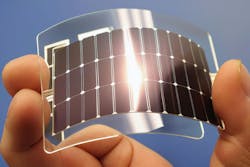Fun Innovations Friday: Game-Changing Solar Technology Enables Energy Generation From Any Surface
A few houses down the street from me, one of my neighbors has solar panels on their roof. Living in Northeast Ohio, I constantly wonder how much actual energy they're saving since we only get around 3 to 4 months of good sunlight a year. The rest of the days are gray.
Even our T.V. remote has a solar panel on the back for charging it's batteries. Why? I have no idea. But it's there.
When I go camping, I have a charger that has a solar panel so it can sit out in the sun and charge instead of worrying about trying to plug it into the car or bringing extra chargers.
These are only a few examples of applications for solar panels, but I think we might start to see more adoption of everyday objects with a new development from Oxford University.
Scientists at Oxford University Physics Department have developed a new way to generate solar electricity without the need for silicon-based solar panels with a new power-generating material that can be coated onto the surfaces of everyday objects. The light-absorbing material is thin and flexible, making it possible to apply to almost any surface, including buildings.
The technique, developed in Oxford, stacks multiple light-absorbing layers into one solar cell, allowing the surface and materials to harness a wider range of the light spectrum and generate more power from the same amount of sunlight.
According to Oxford, the material has been independently certified to deliver over 27% energy efficiency, for the first time matching the performance of traditional, single-layer, energy-generating materials known as silicon photovoltaics. Japan's National Institute of Advanced Industrial Science and Technology (AIST), gave its certification before the publication of the researchers' scientific study later this year.
"During just five years experimenting with our stacking or multi-junction approach we have raised power conversion efficiency from around 6 to over 27%, close to the limits of what single-layer photovoltaics can achieve today. We believe that, over time, this approach could enable the photovoltaic devices to achieve far greater efficiencies, exceeding 45%," said Dr. Shuaifeng Hu, Post Doctoral Fellow at Oxford University Physics.
When compared to the 22% energy efficiency of solar panels currently, it seems promising. But the flexible material is also a key player here. At just over one micron thick, it's almost 150 times thinner than a silicon wafer. Unlike existing photovoltaics, generally applied to silicon panels, this can be applied to almost any surface.
"By using new materials which can be applied as a coating, we've shown we can replicate and out-perform silicon whilst also gaining flexibility. This is important because it promises more solar power without the need for so many silicon-based panels or specially-built solar farms," said Dr. Junke Wang, Marie Skłodowska Curie Actions Postdoc Fellow at Oxford University Physics.
The researchers believe that this innovative solar material and technique could provide a new platform for the industry by reducing the need for silicon panels and purpose-built solar farms as these materials can be manufactured and placed on existing buildings, vehicles, and objects, increasing sustainability and saving costs.
The researchers are among 40 scientists working on photovoltaics led by Professor of Renewable Energy Henry Snaith at Oxford University Physics Department. Their work in photovoltaics began around a decade ago and benefits from a bespoke, robotic laboratory.
Oxford PV, a UK company spun out of Oxford University Physics in 2010 by co-founder and chief scientific officer Professor Henry Snaith to commercialize perovskite photovoltaics, recently started manufacturing perovskite photovoltaics at its factory in Brandenburg-an-der-Havel, near Berlin, Germany. This is the world's first volume manufacturing line for 'perovskite-on-silicon' tandem solar cells.
"We originally looked at UK sites to start manufacturing but the government has yet to match the fiscal and commercial incentives on offer in other parts of Europe and the United States,’ Professor Snaith said. ‘Thus far the UK has thought about solar energy purely in terms of building new solar farms, but the real growth will come from commercializing innovations—we very much hope that the newly-created British Energy will direct its attention to this."
Maybe one day I will be able to buy a solar panel coating to stick to myself to give me more energy. It could work like that, right?
Fun Innovations Friday
Created by the editors of New Equipment Digest and Plant Services, Fun Innovations Friday is a feel-good blog that showcases how advances in science, math, engineering, and technology are making our world more whimsical. Here’s another post that is guaranteed to brighten your day.
Fun Innovations Friday: Researchers Create Chip-Based 3D Printer That's Smaller Than a Coin
3D printers might be going the way of computers with a new focus on miniaturizing the tech as one team of researchers from MIT and the University of Texas developed the first chip-based, non-mechanical 3D printer that's smaller than a coin.
About the Author
Laura Davis
Editor-in-Chief, New Equipment Digest
Laura Davis is the editor in chief of New Equipment Digest (NED), a brand part of the Manufacturing Group at EndeavorB2B. NED covers all products, equipment, solutions, and technology related to the broad scope of manufacturing, from mops and buckets to robots and automation. Laura has been a manufacturing product writer for eight years, knowledgeable about the ins and outs of the industry, along with what readers are looking for when wanting to learn about the latest products on the market.
